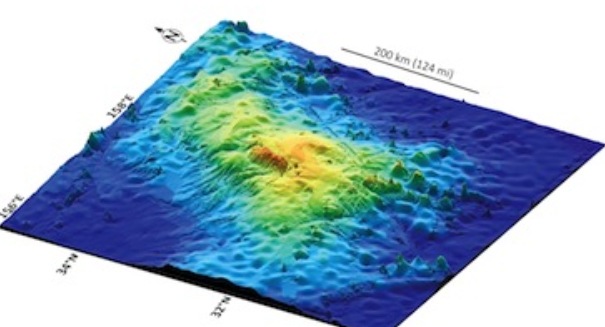
The volcano is thought to be approximately 145 million years old.
According to a news release from the University of Houston, scientists have confirmed the existence of the largest single volcano on Earth. Known as the Tamu Massif, this volcano covers an area approximately the same size as the state of New Mexico. In fact, this volcano is almost as larger as the gigantic volcanoes of the Red Planet, making it one of the biggest in the Solar System.
Approximately 20 years after starting his study of Tamu Massif at Texas A&M’s College of Geosciences, professor William Sager of the University of Houston led the effort to confirm its existence.
Situated approximately 1,000 miles east of Japan, the volcano is the biggest feature of Shatsky Rise, an underwater mountain range created 130 to 145 million years ago by the eruption of multiple underwater volcanoes. Prior to this study, scientists were unsure whether Tamu Massif was a single volcano, or a blend of many eruption points. By combining several sources of evidence, including core samples and data gathered by researchers on board the JOIDES Resolution research ship, the scientists have confirmed the existence of the largest single volcano on Earth. That is to say that the accumulation of basalt that makes up Tamu Massif did undoubtedly erupt from a single source in close proximity to the center.
“Tamu Massif is the biggest single shield volcano ever discovered on Earth,” Sager noted. “There may be larger volcanoes, because there are bigger igneous features out there such as the Ontong Java Plateau, but we don’t know if these features are one volcano or complexes of volcanoes.”
Tamu Massif is also unique because of its shape. It is low and broad, suggesting that the erupted lava flows must have journeyed great distances compared to most other volcanoes on our planet. The seafloor is littered with thousands of underwater volcanoes, most of which are tiny and steep compared to Tamu Massif.
“It’s not high, but very wide, so the flank slopes are very gradual,” Sager added. “In fact, if you were standing on its flank, you would have trouble telling which way is downhill. We know that it is a single immense volcano constructed from massive lava flows that emanated from the center of the volcano to form a broad, shield-like shape. Before now, we didn’t know this because oceanic plateaus are huge features hidden beneath the sea. They have found a good place to hide.”
Olympus Mons, the volcano on the Red Planet, is the only volcano in the solar system worthy of comparison to Tamu Massif. According to scientists, the Martian volcano is approximately 25 percent bigger by volume than Tamu Massif.
The scientists examined two “complementary” sources of evidence to confirm the existence of Tamu Massif: core samples gathered on Integrated Ocean Drilling Program Expedition 324 in 2009, and seismic reflection data collected on two separate trips of the R/V Marcus G. Langseth in 2010 and 2012. Seismic reflection data, for example, showed the structure of the volcano, proving that the lava flows originated from its summit and moved hundreds of miles downhill into the neighboring basins.
According to the scientists, the volcano is thought to be approximately 145 million years old.
“It’s shape is different from any other sub-marine volcano found on Earth, and it’s very possible it can give us some clues about how massive volcanoes can form,” Sager posited. “An immense amount of magma came from the center, and this magma had to have come from the Earth’s mantle. So this is important information for geologists trying to understand how the Earth’s interior works.”
The study’s findings are discussed in greater detail in the journal Nature Geoscience.

Glad to reply